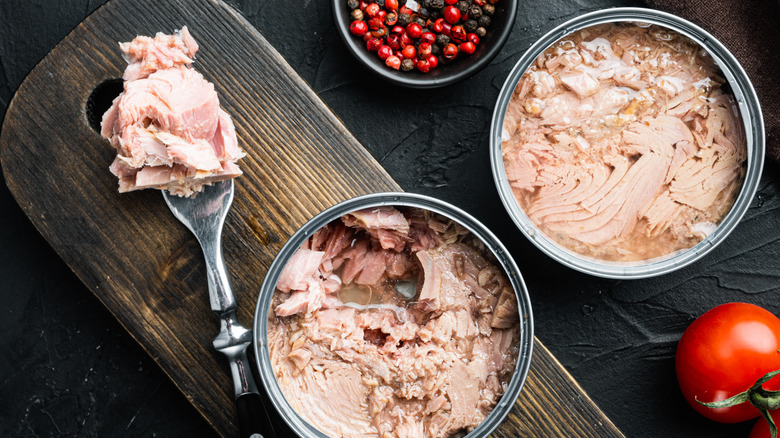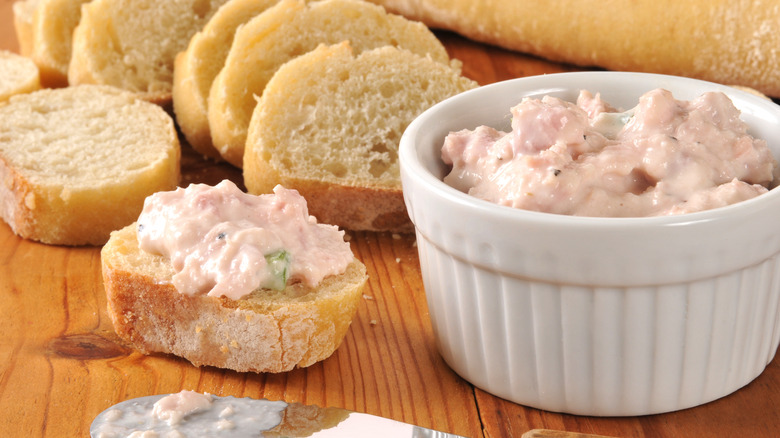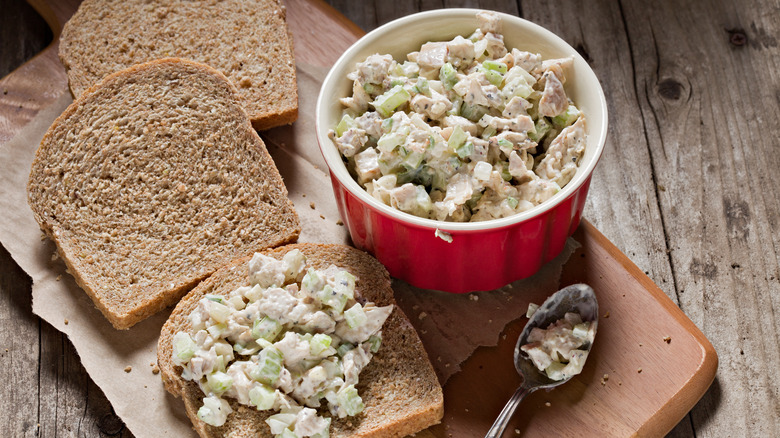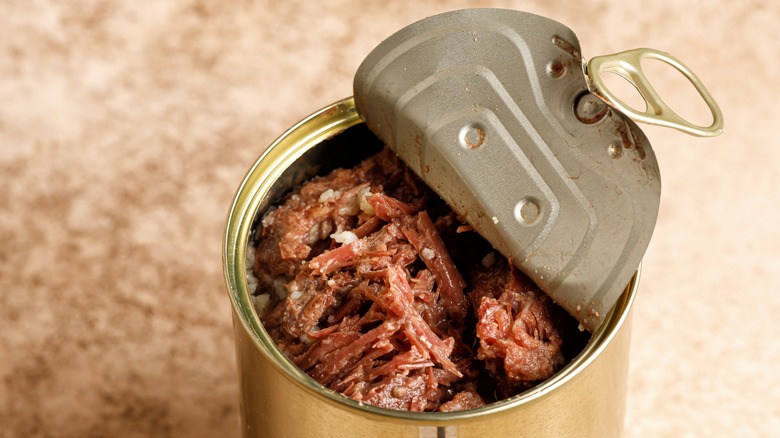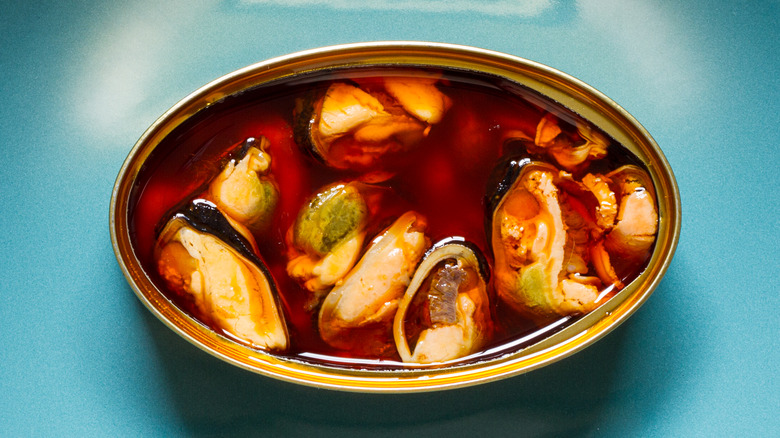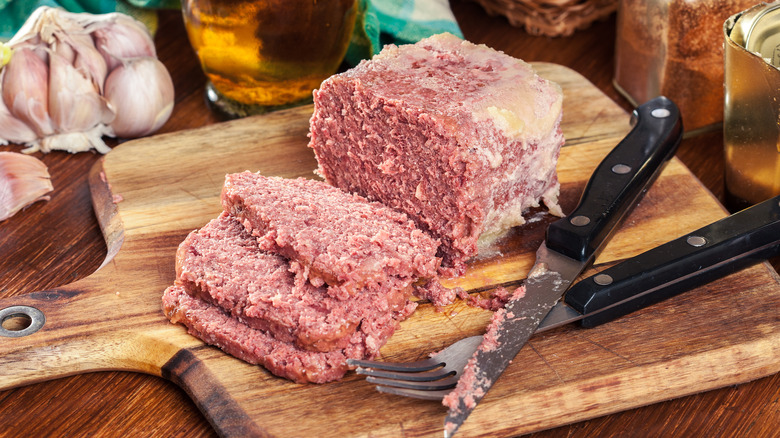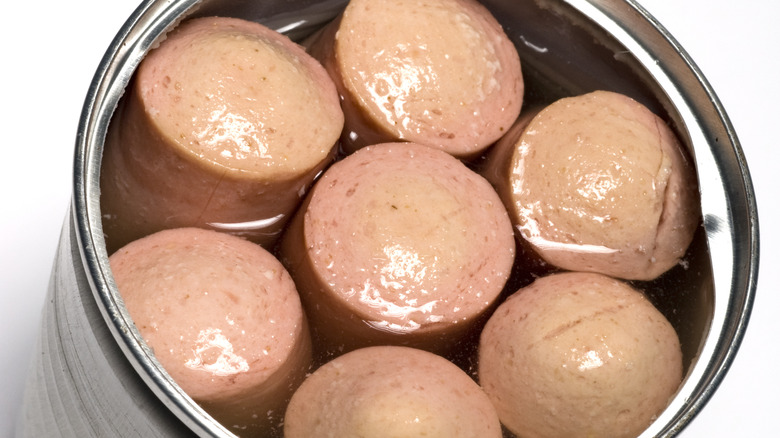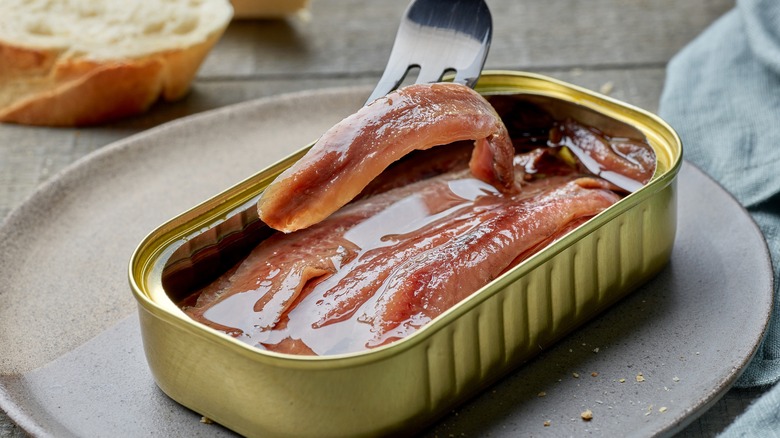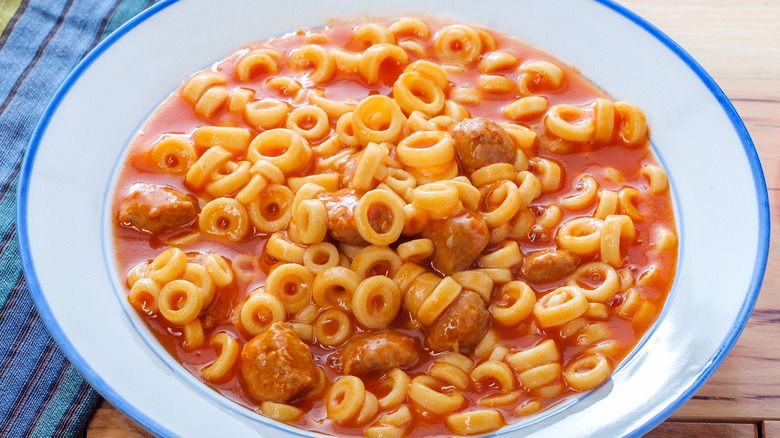6 Canned Meats You Should Buy And 4 You Should Avoid
We may receive a commission on purchases made from links.
As a kid, I remember being fascinated by the fact that you could get meat from a can. It seemed so counterintuitive — meat was supposed to be warm and juicy when it was cooked. It wasn't supposed to be cool, gelatinous, and a little funky tasting. But as I got older and tried more canned meats here and there, my opinions began to evolve. Canned meats were quick — perfect when you needed a fast, on-the-go snack, or wanted to pop something in the microwave. They were relatively affordable, especially compared to fresh meat. And sometimes, that canned meat gave you flavors and convenience that you just couldn't get from fresh or frozen cuts of the very same protein. Turns out there was a reason for meat in a can to exist.
In truth, people have been eating canned meats of all sorts for more than 200 years. At first, we didn't have fridges or freezers, so canned meats were a necessity. But flash forward a couple of centuries, and we're still downing them by, well, the can full. And that's a good thing. Well, most of the time, because while there are plenty of great canned meats out there, there are also some definite losers — products no one should enjoy.
Which canned meat is a "yay" and which is a "nay?" Grab your shopping list and keep reading, as I sort through my picks for the canned meats everyone needs in their pantry — and the ones everyone should always avoid.
Buy: Canned tuna
Canned tuna comes in many forms; in general, all of them are good and deserve a place in your pantry. Skipjack and Albacore are different species of tuna — the former has a stronger, fishier flavor, and the latter is more mild and versatile. Both are delicious. You might also see terms like white, light, or chunk light on your can of tuna — this, again, refers to the species of fish, with albacore being the "white" variety of tuna and skipjack being the "light."
Most home cooks have many questions about canned tuna; the most common is whether you should buy your tuna packed in oil or water. One easy way to decide is if you're going to drain the fish for your recipe, buy water-packed. But if you want to use the entire contents of the can, like in a salad or soup, buy oil-packed and enjoy all that extra richness and moisture.
Whichever variety of tuna you ultimately decide on, stock up. This is one canned protein you can't have too much of. Canned tuna is ideal for making everything from sandwiches and tuna melts to pasta dishes, casseroles, beautiful tuna salads, tuna wraps, and more. It's also good value for money as well as time. Popping open a can to make any of these dishes is infinitely quicker than cooking fresh tuna — and both versions of the fish taste close enough that you aren't losing any flavor or quality by going with the canned option.
Avoid: Potted sandwich spread
Potted sandwich spread — or canned deviled ham, as it is sometimes known — is meat that has been mixed with fat and spices. It's then ground and cooked down to a spread-like consistency. It's an unusual canned meat product, and while there must be somebody out there who likes it — they keep making the stuff, after all — it's generally a massive disappointment and a canned meat we could all benefit from avoiding.
Perhaps the biggest drawback with this "ham spread" is the taste. It's uber-processed. Companies use a variety of lower-quality meats (many of which are "mechanically separated," whatever that means). They're mixed together, some spices are thrown in, and then everything is cooked down to a paste. There are all sorts of added flavors, preservatives, and fillers, many of which also lend the product a strange and often off-putting flavor. Then, there's the texture. Mushy, gritty, and way over-manufactured.
Instead of buying this strange spread, make your own. Start with a meat you like and recognize, like roasted or smoked ham, turkey, or chicken. Put it in your food processor. Then add your condiments and spices—mayo, mustard, garlic, onion, dill, paprika, or whatever you enjoy. Chop to a chunky consistency, or process until super smooth — again, it's up to you. Whatever you create, I guarantee it has more potential than any "potted meat spread" you might pop open.
Buy: Canned chicken breast
Like canned tuna, canned chicken breast is another excellent and tasty time saver. It's a good source of protein and other nutrients. It has an incredibly long shelf life — three to five years at a minimum, though some say much longer. And, perhaps best of all, you can use it in countless ways. Infinitely quicker than cooking fresh or frozen chicken from scratch, this canned chunk meat still has the mild, savory flavor of roast or broiled chicken breast you're expecting, making it ideal for a wide variety of uses.
To whip up an impressive chicken salad in five minutes or less, simply open a can of chicken breast, drain it, and mix it with mayonnaise, celery, diced onions or chives, plus spices like paprika, dill, mustard, basil, or thyme. To turn your salad into a heartier meal, stir in cherry tomatoes, frozen peas or corn, diced hard-boiled egg, black beans, and more. Eat the salad as is, pile it into a sandwich or wrap, scoop it over garden greens, or toss it with pasta — it's incredible, no matter how you choose to enjoy it.
Canned chicken is also a fantastic ingredient for cheesy casseroles, chicken tacos, quesadillas, homemade pot pies, curries, rice dishes, and even chicken noodle soup. For a hearty and filling no-fuss weeknight meal, just boil some pasta, open a can or two of chicken breast, and grab your favorite bottled alfredo sauce. Then, combine it all, heat, and serve.
Avoid: Canned roast beef
There's no gentle way around this one: Canned roast beef has a distinct dog food (or cat food) quality, depending on what type of furry friend you share your home with. Fresh from the oven or slow cooker, freshly cooked roast beef is a feast for the senses. It has that bold and unmistakable beef flavor. There are bits of caramelization and smokiness. Delicious juices and complex umami flavors that sing as they cross your tongue.
But in a can, roast beef has none of that wonderfulness. It's incredibly salty — saltier than even the norm for most canned foods. The texture is gooey and stringy. And instead of beef, the predominant flavor you taste is metal. There's just nothing redeeming about canned roast beef at all, which is a shame.
A much better alternative, especially if you're a roast beef lover, is making your own. Just cook the biggest roast you can, in the oven or in your crockpot. Then, portion that cooked meat into whatever size servings you want and freeze it — it will easily keep for months. This way, you have delicious, ready-to-eat cooked roast beef on hand whenever you need it — for both you and your pets. They don't want that stuff in the can, either.
Buy: Canned salmon
Rounding out my trifecta of the most delicious, versatile, and foundational canned meats, you can't go wrong with canned salmon. While fresh salmon can still be hard to come by in some landlocked states, and frozen salmon isn't always affordable, canned salmon is the great equalizer. It's widely available, moist, and juicy, and can be used in innumerable recipes, from appetizers to soups and chowders — even many different mouth-watering main courses.
One favorite canned salmon dish for many is the classic, old-school salmon burger. This alternative to ground beef patties is made by combining bread crumbs, mayo, and spices to form a patty, which you then fry just like a traditional hamburger. Your salmon patty can be eaten on its own — much like a crab cake — or sandwiched in a pillowy bun with your favorite go-to burger condiments.
Beyond burgers, canned salmon is also ideal for green salads, frittatas, pasta dishes, and even a rich and savory dip you can serve at your next get-together. Just blend canned salmon with cream cheese, sour cream, lemon juice, and herbs. Mix to your desired consistency — smooth or chunky — and serve with crackers or veggies.
Canned salmon is also the ideal option — better than freshly cooked salmon in many ways — for a spectacular chowder. Start your one-pot meal by sautéing diced onions, celery, and garlic in a pot until softened. Then, add diced cooked potatoes, corn, broth, salmon, cream, and dried or chopped herbs. Simmer until hot and serve.
Buy: Canned sardines
Sardines aren't for everyone. If you don't like fish, you're not going to be into them — canned, fresh, frozen, or otherwise. But for seafood lovers, canned sardines are a given for any list of canned meats you should be buying. Sardines have a bold, rich, umami-packed flavor with a hint of saltiness that's unique not just among canned meats but also fish in general. They're fantastic right from the can — plain or packed in a tomato sauce, mustard, or even various oils or brines. You can also stuff sardines in a sandwich, eat them in a salad, toss them with pasta, or even use them to garnish a pizza.
But don't stop there. One of the reasons sardines are such a perfect canned meat is because they can be used in so many fantastic and unexpected ways. Pile them high on toast and drizzle with balsamic glaze to make a sardine crostini. Make a dip by folding diced sardines with cream cheese, lemon zest, and herbs, and then spread on crackers. Or, indulge in them for breakfast. Sardines complement eggs amazingly. Fold them into an omelet, layer them in a frittata, or just scramble them with eggs and pair them with a crusty slice of toast.
Avoid: Canned mussels
Some canned seafood is amazing. Tuna. Salmon. Sardines, as I just detailed. Unfortunately, canned mussels are not part of that list. Freshly cooked, mussels are a fantastic treat. They have a rich, savory flavor that yields equal parts earthiness, umami, and even sweet nuttiness. The flavor is bold yet also delicate. Mussels absorb the flavors of the herbs and spices they're cooked with, creating an almost herbal, buttery quality that floods the palate with flavor. They're a true culinary delight.
But canned mussels are a different beast altogether. Their flavor is strong and briny — almost overpowering in some cases. They can also have a metallic quality that is quite offputting. And their texture is no better. There's no mixture of tenderness and firmness like you find in fresh mussels. Instead, the meat is both rubbery and chewy — sometimes verging on being so tough the mussels can be hard to bite through.
Save yourself the headache. Buy fresh mussels instead, if they're available. Or opt for frozen, which can be equally as tasty. Then dig into one of these super tasty weeknight mussel recipes — no cans required.
Buy: Canned corned beef
With its bold, robust flavor, corned beef is a favorite at St. Patrick's Day and throughout the year. Fun fact: eating corned beef in March is not actually an Irish tradition! The cured meat is slightly spiced — thanks to a combination of cloves, allspice, coriander, and peppercorns. It's earthy, has a hint of sweetness, and packs just the right amount of tang. No wonder it's a comfort food classic.
But while traditionally prepared corned beef is marbled, tender, and crumbly, the canned version is unique and distinct in its own way. Despite similar flavor profiles, in a lot of ways, it's a completely different (yet still delicious) dish. Canned corned beef has a more concentrated flavor. It also has a denser, more uniform texture — it's a lot like a pâté after being tightly packed into its can. You can love regular corned beef and canned corned beef and not feel like one is an inferior version of the other — instead, they complement one another. Think of them as fraternal twins, rather than identical twins. They've got the same genetics, but each has its own unique traits and personality.
Avoid: Canned whole chicken
Yes, it's true. In some markets, you can find an entire cooked chicken — bones and all — in a can. Which brings us to the question: Why? Even if you are able to can something, why do it... especially if the end result is going to be so gross?
In theory, canned chicken is meant to be used in dishes like chicken salad, or chicken noodle soup. But even if you can wrap your head around the canned chicken's bizarre appearance (it slides out of the can covered in the same sort of goo you often see on newborn babies on T.V.), there's still no real reason to buy this product. Canned chicken breast tastes infinitely better, and doesn't have the slime. And, you still have to deal with bones and waste, so it's not like the canned whole chicken is saving you a lot of time or energy.
My advice is to stick with fresh, frozen — or even store-cooked rotisserie chicken if you're in a hurry. And avoid this monstrosity at all costs.
Buy: Spam
Spam was introduced to the American public in 1937, and it's been a shining example of how good canned meat can be ever since then. A combination of the words that make up its description — "spiced ham" — Spam is an entirely unique product. Canned tuna is tuna — you'll never think it's something else. The same is true for canned chicken breast. It's just chicken from a can. But Spam is not really ham at all. Aside from the slight smokiness that both meats possess, there's no comparison. Spam is more savory. It's saltier. It's firmer and more dense and compact, even compared to processed boneless ham. There's nothing else like it.
Spam can get a bad rap from the haters. But for those who understand and appreciate it for the delicious and unique product it is, it's a must-buy to include on your shopping list. You can eat it hot in sandwiches, fry it up as a snack, scramble it with eggs, toss it in a salad, or pair it with rice in a poke-style bowl. Love mac and cheese? Make it even better by throwing in some diced Spam. Grill it with pineapple on a skewer. Throw some in your ramen. And if you know how to make your own sushi, there's nothing quite as decadent (or mouthwatering) as a Spam sushi roll.
Avoid: Vienna sausages
Like Spam, Vienna sausages are another one-of-a-kind product — like a cross between a hot dog and a cocktail sausage, but (sadly) not as good as either. For some people, the problem with these canned links is their taste. They're overly processed and artificial tasting, and pack none of the punch of a fresh (or even frozen) sausage. Other people loathe Vienna sausages because of their texture, which lurks somewhere in the murky territory between mushy, rubbery, and even slightly spongy.
For me, the biggest issue with Vienna sausages is the fatty liquid they're packed in. I want to like it, but it's not rich and indulgent enough to be a guilty pleasure. If the can is too cold, it's firm and gelatinous and clings to the sausages in the most unappealing way. And if the can is warm, this strange liquid oozes around them like some kind of strange foreign gel. Both states are equally unappetizing, and only further remind me why Vienna sausages are one canned meat I am always careful to avoid.
Buy: Canned anchovies
I already extolled the virtues of canned sardines, but anchovies are just as deserving of a slot on any list of must-buy canned meats. For those of us who didn't major in zoology, sardines and anchovies are two completely different species of fish, and each has their own unique and wonderful flavor profile. Sardines are bigger fish in general than anchovies. They also have a more mild fish flavor. Anchovies are smaller, more pungent, and saltier (since they're often cured in salt or brine). Although interchangeable in many recipes, each warrants its own place of honor in your pantry.
Anchovies are a fantastic pizza topping, especially if you enjoy Mediterranean-style seafood-forward dishes. But anchovies can also be used in many ways you might not use a sardine. For instance, how about making a marvelous anchovy butter that you can use on grilled meats or veggies? Simply mash canned anchovies with softened butter and garlic, then spread as needed. You can also use anchovies in all kinds of sauces, from a one-of-a-kind aioli (blend them with mayo, garlic, lemon juice, and Dijon mustard) to pesto to a savory vinaigrette for a classic garden salad.
They're also a unique addition to canned or homemade pasta sauces and DIY olive tapenades (just combine the fish with your olives before blending). Or, pair your canned anchovies with goat cheese to make a show-stopping crostini. Let's see you do that with fresh fish.
Avoid: Canned meatballs (of any type)
No matter what form they come in — packaged on their own, included as part of a sauce, or paired with pasta — canned meatballs are never a good idea. They suffer the same problem as potted meat: They aren't made with high-quality protein. Instead, canned meatballs are made from a mixture of cheap, processed meats. They're combined with fillers like bread crumbs and weird concentrates. And, they often contain flavorings and preservatives as well. They might come in handy if you were stranded in a jungle or an Arctic igloo. Definitely save a couple for the zombie apocalypse. But for day-to-day casual eating, you can do better.
Instead of buying canned meatballs, make your own. Try a selection of meatball recipes from around the world and pick a favorite. Then, make a bunch and freeze them. Or, just buy pre-made frozen meatballs to start with. Toss 'em in your microwave or air fryer and they'll be browned, toasty, and ready to eat in just about the same time it would take to heat up those terrible canned meatballs. They're also sure to taste better.
Methodology
As a true foodie since birth, I've been fascinated with various types of food — what you should buy, how to use it, and what to steer clear of — for as long as I can remember. Professionally, I've also been writing about food and nutrition for publications and outlets, both large and small, for more than 20 years. My picks for this piece come from years of experience cooking myself, plus interviewing a vast number of the country's best chefs and nutritionists. I've also tried each and every one of the canned foods mentioned here. Some are favorites I enjoy often, others... well, one time was enough.
All of that first-hand experience, plus the expert knowledge I've garnered from folks I've interviewed, has been distilled down into the list you just read. I hope it encourages you to fill your pantry with some of the wonderful canned meats available today so you can explore all their varied — and delicious — potential uses. Pop open a can, and happy cooking.

